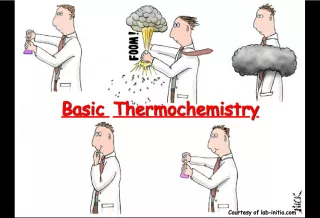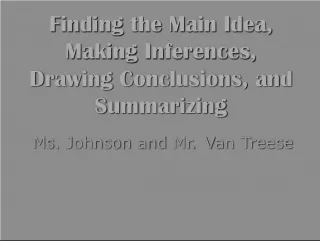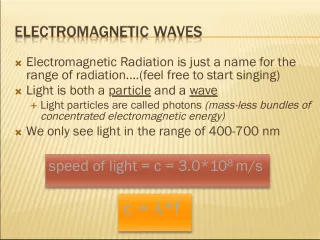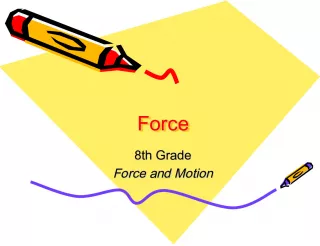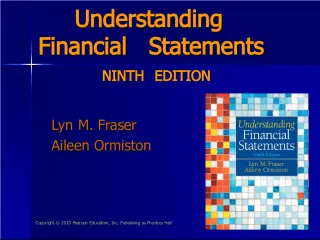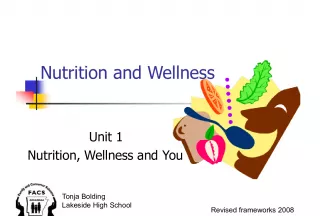Understanding Thermochemistry
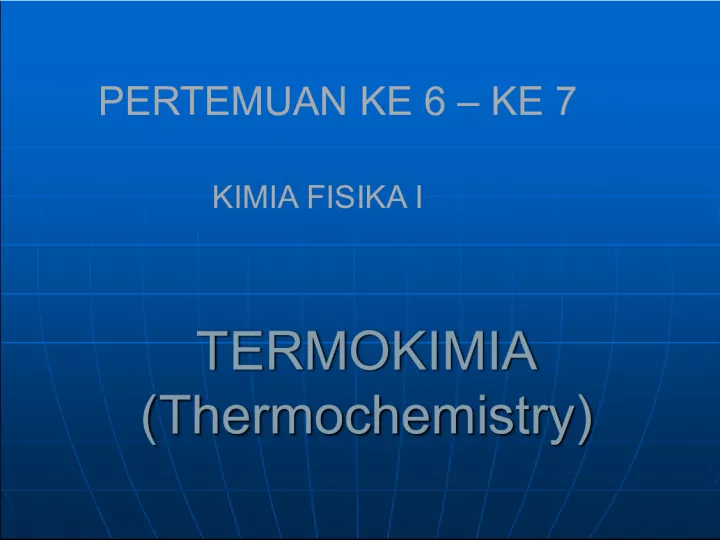

This article discusses the fundamentals of thermochemistry, which is the study of energy transfer during chemical reactions. It explains how thermochemistry is a branch of thermodynamics, as chemical reactions involve the exchange of energy between
- Uploaded on | 1 Views
-
 ayaan
ayaan
About Understanding Thermochemistry
PowerPoint presentation about 'Understanding Thermochemistry'. This presentation describes the topic on This article discusses the fundamentals of thermochemistry, which is the study of energy transfer during chemical reactions. It explains how thermochemistry is a branch of thermodynamics, as chemical reactions involve the exchange of energy between. The key topics included in this slideshow are . Download this presentation absolutely free.
Presentation Transcript
Slide1TERMOKIMIA(Thermochemistry) TERMOKIMIA (Thermochemistry) PERTEMUAN KE 6 – KE 7 KIMIA FISIKA I
Slide2•The study of the energy transferred as heat during the course of chemical reactions is called thermochemistry. • Thermochemistry is a branch of thermodynamics because a reaction vessel and its contents form a system, and chemical reactions result in the exchange of energy between the system and the surroundings. • Thus we can use calorimetry to measure the energy supplied or discarded as heat by a reaction, and can identify q with a change in internal energy (if the reaction occurs at constant volume) or a change in enthalpy (if the reaction occurs at constant pressure). • Constant pressure; q p = H • Constant volume ; q v = U
Slide3•Conversely, if we know U or H for a reaction, we can predict the energy (transferred as heat) the reaction can produce. • Conversely, if we know U or H for a reaction, we can predict the energy (transferred as heat) the reaction can produce. • We have already remarked that a process that releases energy by heating the surroundings is classified as exothermic and one that absorbs energy by cooling the surroundings is classified as endothermic. • We have already remarked that a process that releases energy by heating the surroundings is classified as exothermic and one that absorbs energy by cooling the surroundings is classified as endothermic. • Exothermic ∆H<0 • Exothermic ∆H<0 • Endothermic ∆H>0 • Endothermic ∆H>0
Slide4Heat reaction is influenced by: Heat reaction is influenced by: - amount of matter - Physical state - Temperature - Pressure - Type of reaction (P constant or V constant) To writing the equation of chemical reaction need to write state (l,ag,s,), coeficient and experiment condition.. Example : Reaction of formation CO 2 in1 atm and 298 K C (grafit) + 2O 2 (g) CO 2 (g) +393,515 kJ
Slide5Change of energy in constant pressure (atmosferic pressure), so Change of energy in constant pressure (atmosferic pressure), so H = q p H = q p In Reaction : aA + bB cC + dD + x kJ In Reaction : aA + bB cC + dD + x kJ If enthalpy of reactant = H1 If enthalpy of reactant = H1 Enthalpy of product = H2 Enthalpy of product = H2 So : So : H1 = H2 + x kJ H1 = H2 + x kJ H2-H1 = -x kJ H2-H1 = -x kJ H = -x kJ H = -x kJ
Slide6•Changes in enthalpy are normally reported for processes taking place under a set of standard conditions. • In most of our discussions we shall consider the standard enthalpy change ∆H o , the change in enthalpy for a process in which the initial and final substances are in their standard states • The standard state of a substance at a specified temperature is its pure form at 1 bar. Standard enthalpy changes
Slide7•For example, the standard state of liquid ethanol at 298 K is pure liquid ethanol at 298 K and I bar; the standard state of solid iron at 500 K is pure iron at 500 K and 1 bar. • For example, the standard state of liquid ethanol at 298 K is pure liquid ethanol at 298 K and I bar; the standard state of solid iron at 500 K is pure iron at 500 K and 1 bar. • The standard enthalpy change for a reaction or a physical process is the difference between the products in their standard states and the reactants in their standard states, all at the same specified temperature. • The standard enthalpy change for a reaction or a physical process is the difference between the products in their standard states and the reactants in their standard states, all at the same specified temperature. • As an example of a standard enthalpy change, the standard enthalpy of vaporization, ∆H o vap , is the enthalpy change per mole when a pure liquid at 1 bar vaporizes to a gas at 1 bar, as in • As an example of a standard enthalpy change, the standard enthalpy of vaporization, ∆H o vap , is the enthalpy change per mole when a pure liquid at 1 bar vaporizes to a gas at 1 bar, as in
Slide8Enthalpies of physical change• The standard enthalpy change that accompanies a change of physical state is called the standard enthalpy of transition and is denoted ∆ trans H o • The standard enthalpy of vaporization, ∆ Vap H o is one example. • Another is the standard enthalpy of fusion, ∆ Fus H o , the standard enthalpy change accompanying the conversion of a solid to a liquid, as in
Slide11Enthalpies of chemical change Enthalpies of chemical change 2A + B 3C + D the standard reaction enthalpy is • We consider enthalpy changes that accompany chemical reactions. There are two ways of reporting the change in enthalpy that accompanies a chemical reaction. One is to write the thermochemical equation, a combination of a chemical equation and the corresponding change in standard enthalpy: Or
Slide12Hess's law Hess's law • Standard enthalpies of individual reactions can be combined to obtain the enthalpy of another reaction. • This application of the First Law is called Hess's law • The standard enthalpy of an overall reaction is the sum of the standard enthalpies of the individual reactions into which a reaction may be divided. • The individual steps need not be realizable in practice: they may be hypothetical reactions, the only requirement being that their chemical equations should balance.
Slide13•The thermodynamic basis of the law is the path-independence of the value of ∆ r H o and the implication that we may take the specified reactants, pass through any (possibly hypothetical) set of reactions to the specified products, and overall obtain the same change of enthalpy. • The thermodynamic basis of the law is the path-independence of the value of ∆ r H o and the implication that we may take the specified reactants, pass through any (possibly hypothetical) set of reactions to the specified products, and overall obtain the same change of enthalpy. • The importance of Hess's law is that information about a reaction of interest, which may be difficult to determine directly, can be assembled from information on other reactions. • The importance of Hess's law is that information about a reaction of interest, which may be difficult to determine directly, can be assembled from information on other reactions.
Slide14Example2.8:
Slide15LatihanLatihan Jika entalpi pembakaran standar 1-heksena dan heksana masing2 adalah -4003 kJ mol -1 dan -4163 kJ mol -1 dan entalpi pembentukan air adalah -285,83 kJ mol -1 . Hitung entalpi hidrogenasi standar dari 1-heksena menjadi heksana. Jika entalpi pembakaran standar 1-heksena dan heksana masing2 adalah -4003 kJ mol -1 dan -4163 kJ mol -1 dan entalpi pembentukan air adalah -285,83 kJ mol -1 . Hitung entalpi hidrogenasi standar dari 1-heksena menjadi heksana.
Slide17Standard enthalpies of formation ∆H o f Standard enthalpies of formation ∆H o f • The standard enthalpy of formation, ∆H o f , of a substance is the standard reaction enthalpy for the formation of the compound from its elements in their reference states. • The reference state of an element is its most stable state at the specified temperature and 1 bar. • Standard enthalpies of formation are expressed as enthalpies per mole of molecules or (for ionic substances) formula units of the compound Formulation of reaction entalphy
Slide18Exercise 2.14, 2.15 2.16, 2.17 and 2.20 Exercise 2.14, 2.15 2.16, 2.17 and 2.20
Slide19Contoh soal 2.20 Contoh soal 2.20 0,3212 gram glukosa dibakar dalam kalorimeter bom yang kapasitas kalornya 641 J K -1 , temperatur naik 7,793 K. Hitung 0,3212 gram glukosa dibakar dalam kalorimeter bom yang kapasitas kalornya 641 J K -1 , temperatur naik 7,793 K. Hitung entalpi molar pembakaran standar, entalpi molar pembakaran standar, energi dalam pembakaran standar dan energi dalam pembakaran standar dan entalpi pembentukan glukosa standarnya. entalpi pembentukan glukosa standarnya. Jawab: Jawab: Tentukan perub entalpi dari nilai q (q=C∆T) Tentukan perub entalpi dari nilai q (q=C∆T) (Dicari dari hub U dan H (apakah ada perub mol (Dicari dari hub U dan H (apakah ada perub mol gas) gas) Tulis reaksi pembakarannya, kemudian gunakan perub entalpi standar pembentukan dari tabel untuk menentukan entalpi pembentukan standar glukosa Tulis reaksi pembakarannya, kemudian gunakan perub entalpi standar pembentukan dari tabel untuk menentukan entalpi pembentukan standar glukosa
Slide20Macam-macam Panas /Perub entalpi Macam-macam Panas /Perub entalpi Panas atomisasi : Panas yang diperlukan untuk menghasilkan 1 mol zat dalam bentuk gas dari keadaan yang paling stabil pada keadaan standar . Contoh : Panas atomisasi : Panas yang diperlukan untuk menghasilkan 1 mol zat dalam bentuk gas dari keadaan yang paling stabil pada keadaan standar . Contoh : C grafit C(g) H = 716,68 kJ C grafit C(g) H = 716,68 kJ Panas penguapan standar : panas yang diperlukan untuk menguapkan 1 mol zat cair menjadi upanya pada keadaan standar Panas penguapan standar : panas yang diperlukan untuk menguapkan 1 mol zat cair menjadi upanya pada keadaan standar contoh : contoh : H 2 O(l) H 2 O(g) H=44,01 kJ H 2 O(l) H 2 O(g) H=44,01 kJ Panas peleburan standar : panas yang diperlukan atau dilepas pada peleburan . Panas peleburan standar : panas yang diperlukan atau dilepas pada peleburan . Contoh : Contoh : H 2 O(s) H 2 O(l) H = 6,0 kJ H 2 O(s) H 2 O(l) H = 6,0 kJ Panas pelarutan integral: Panas yang timbul atau diserap pada pelarutan suatu zat dalam suatu pelarut. Besarnya tergantung jumlah zat pelarut dan zat terlarut. Panas pelarutan integral: Panas yang timbul atau diserap pada pelarutan suatu zat dalam suatu pelarut. Besarnya tergantung jumlah zat pelarut dan zat terlarut.
Slide21 Panas pengenceran integral : panas yang timbul atau diserap jika suatu larutan dengan konsentrasi tertentu diencerkan lebih lanjut dengan menambahkan pelarut Panas pelarutan diferensial = panas yang timbul atau diserap jika 1 mol zat terlarut ditambahkan ke dalam sejumlah besar larutan tanpa mengubah konsentrasi larutan. Panas Pengenceran diferensial : Panas yang timbul atau diserap jika 1 mol pelarut ditambahkan ke dalam sejumlah larutan tanpa mengubah konsentrasi larutan tersebut. Panas netralisasi : panas yang diserap atau dilepaskan jika 1 mol ekivalen asam kuat tepat dinetralkan oleh 1 mol ekivalen basa kuat. Panas Hidrasi : panas yang timbul atau diperlukan pada pembentukan hidrat. Contoh : CaCl 2 (s) + 2H 2 O (l) CaCl 2 .2H 2 O (s) H = -7960 kal
Slide22ENERGI IKATAN Energi disosiasi ikatan : energi yang diperlukan untuk memutuskan satu buah ikatan pada suatu molekul . Contoh : H 2 (g) 2H (g) H 298 K =435,9 kJ/mol Energi ikatan : rata-rata dari energi disosiasi ikatan total Data energi ikat dapat digunakan untuk meramalkan panas reaksi pada pembentukan molekul sederhana Contoh : C 2 H 2 (g) + 2H 2 (g) C 2 H 6 (g) H= ? Hr = ∑ H pemecahan + ∑ H pembentukan dengan: H pemecahan selalu (+) H pembentukan selalu (-) Contoh 2.7
Slide23Pengaruh suhu terhadap Pengaruh suhu terhadap H Untuk C p konstan Untuk reaksi : A + B C + D
Slide24SehinggaHukum Kirchhoff
Slide25Contoh 2.16
Slide26Berapa perubahan entalpi untuk penguapanair pada suhu 0 o C dengan asumsi bahwa pada suhu 0 – 25 o C Cp tdk tergantung pada T
Slide27Persamaan Kirchoff Jika kapasitas panas pada tekanan tetap sebagai fungsi suhu, maka: Hubungan Cp dengan suhu dapat ditulis: Cp = a+bT+c/T 2 +d/T 3 a,b,c,d adalah tetapan Cp = a+ bT+ c/T 2 + d/T 3
Slide28Exercise1. Cp of n-butane/JK -1 mol -1 = 19,41+ 0,233 T/K Calculate q for increasing of 1 mole n-butane from 25 o C to 300 o C in constant pressure. Answer: Use formula:
Slide29Tentukan kalor yang diperlukan untuk menaikkan suhu 1 mol N 2 dari 25 o C menjadi 25 0 o C pada tekanan tetap, jika nilai kapasitas panasnya tergantung pada temperatur. (Gunakan perumusan Cp sebagai fungsi suhu) Penyelesaian: 1. Tulis pers hukum kirchoff dg Cp fungsi suhu 2. Integralkan persamaan itu 3. Masukkan nilai a, b, dan c dari tabel 2.16 4. Hitung nilainya dengan teliti
